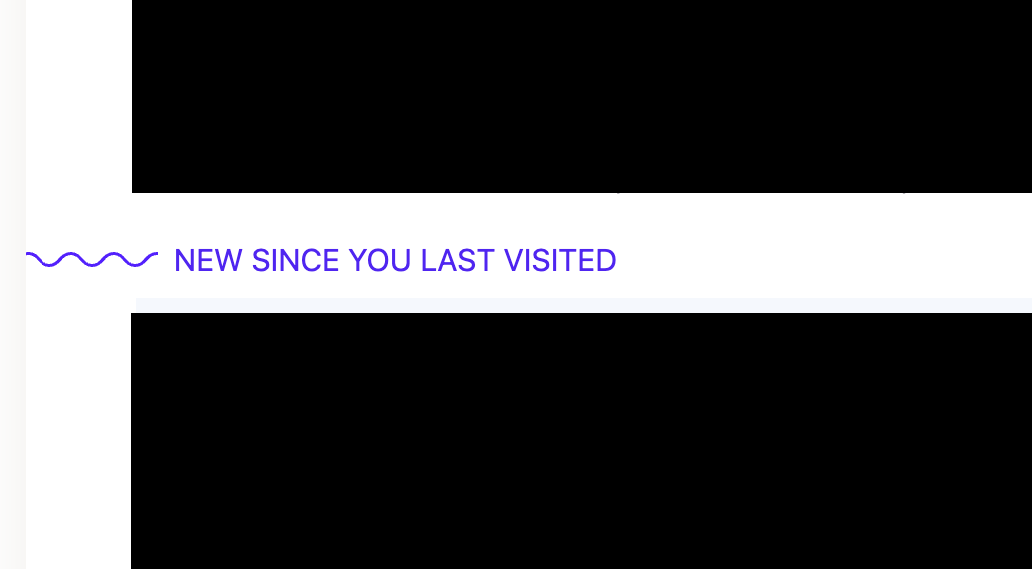A House of Brands refers to a business structure where a parent company owns multiple subsidiary brands, each operating independently and marketed under its own brand name. For example, Procter & Gamble owns Pampers, Duracell, Pringles, Tide, etc. More strikingly, Unilever owns four ice cream brands: Ben & Jerry’s, Magnum, Walls, Paddle Pop, etc.
When does this work: Each sub-brand can operate as an autonomous division with little to no coordination required with other sub-brands.
Why it matters: Operating a house of brand provides multiple advantages:
- As an aggregate, the holding company reduces its risk by diversifying their portfolio across multiple product categories.
- Each sub-brand business owner has the independence to implement their way of doing things (typically using business rules), allowing for specialization in a particular segment, allowing for focused & efficient production, marketing, and distribution strategies.
- There is freedom to experiment with new products and markets without risking the parent brand.
- Each sub-brand can be targeted towards a specific consumer segment.
- Customers have a sense of choice, even though most of the options are operated by the same parent company.
 Copied
CopiedDigital media homepages are cluttered with widgets for various sections, leading to higher bounce rates and accidental clicks.

This difference places the cognitive load and choice fatigue on users.
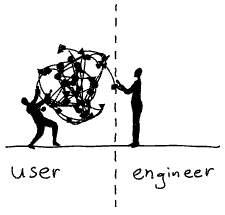
In contrast, algorithmic platforms—social media, search engines, and OTT services—present users with a simple, sorted list of content to choose from.

Meanwhile, on algorithmic platforms, this burden is shifted to the recommender algorithms, making it easier for users to find what they want.

GIF Credits: Ralph Ammer
 Copied
CopiedFormat is the pre-defined technical structure in which bits are stored in software. For example, typically, we use human-readable formats like Google Sheets, MS Excel, PDFs, Google Docs, Websites, etc.
However, these file formats are human-readable formats and aren’t always ideal for use by machines.
- Formatting makes data readable by humans.
- Data for Humans = Data For Machines + Formatting
In Google Sheets, you can do formatting here:
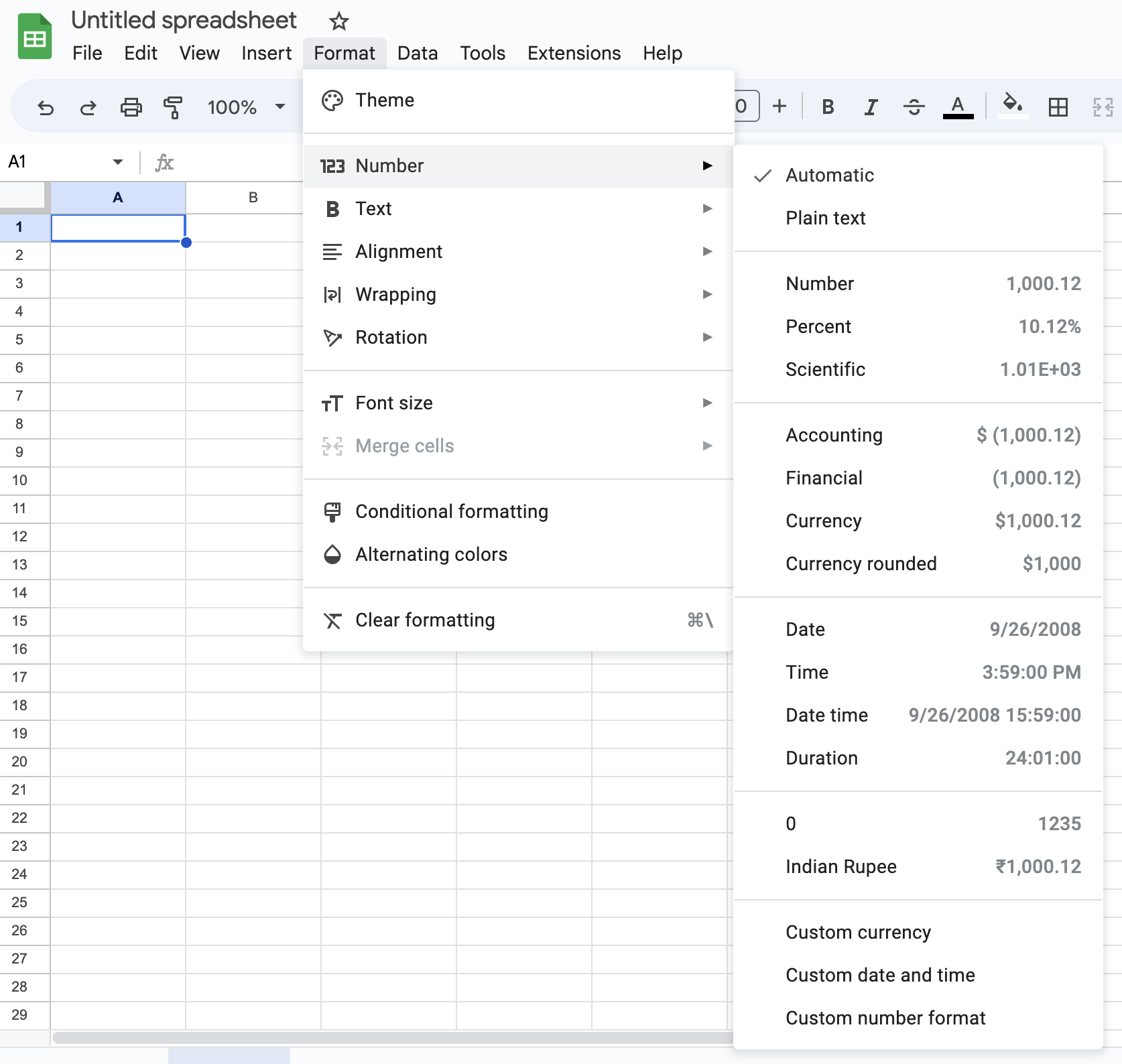
When doing data analysis, you want to strip away the formatting and use machine-readable formats like CSV, XML, JSON, etc.

Machine readable formats follow some form of pattern that algorithms can read quickly. For example, pipe-separated value (PSV) files split columns by | and each row is identified by new line character \n. CSVs separate columns by comma, SSVs separate columns by semicolon, etc.
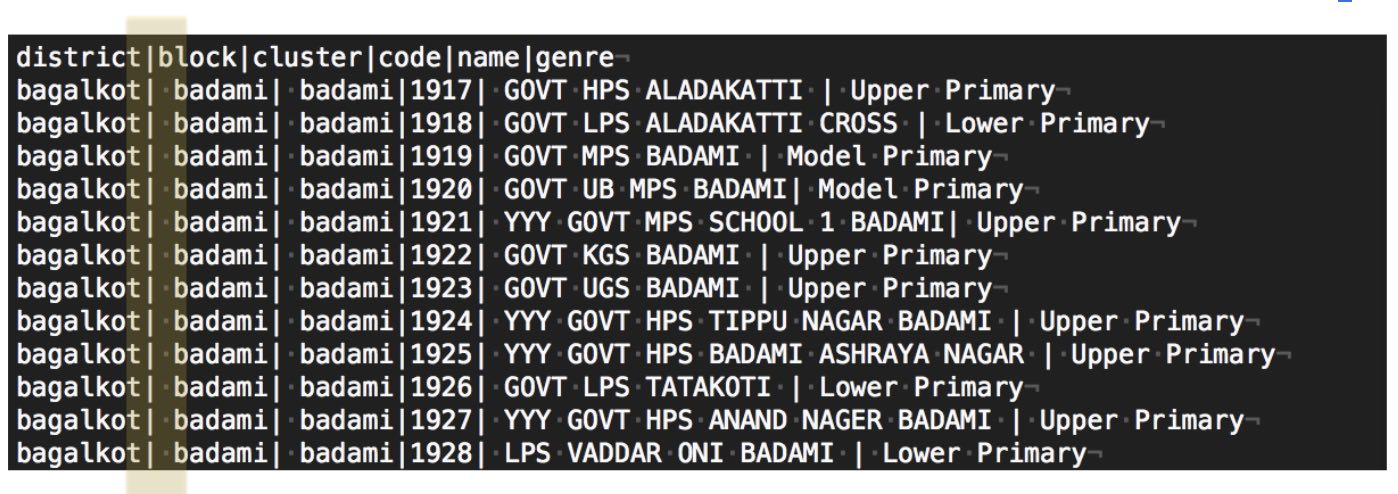
 Copied
CopiedGoogle Sheets stores formatting separately from information. Similarly, the advent of Generative AI will force information products (Search Products, Social Media, etc.) to separate the core information value and the form, format, style, and tone it is presented in. Without this, we are in for a flood of similar content that is written just slightly different.
Historically, modern CMSes like Washington Post’s Arc CMS went headless and started storing the story and its presentation (HTML tags) separately. We’ll now have to extend this further.
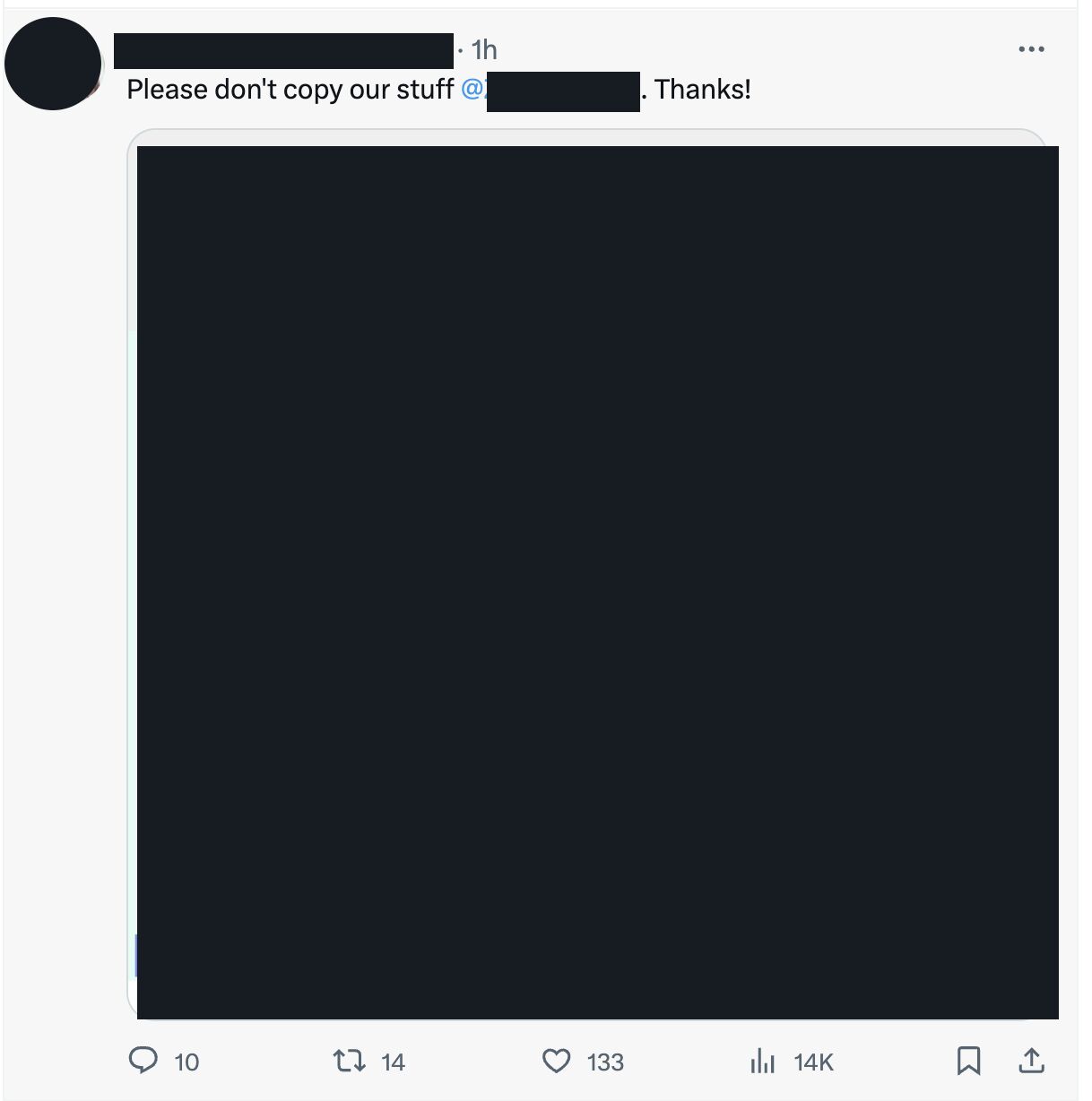
 Copied
CopiedTo create value, make something people want but cannot get easily elsewhere.
You can escape being commoditized if you’ve competitive differentiation.
Why it matters: Differentiation allows you capture value for yourself without worrying about others copying you.
- You could create a lot of value without becoming very valuable yourself.
- Creating value isn’t enough — you also need to capture some of the value you create. In his book Zero to One, Peter Thiel talks about how the US airline companies serve millions of passengers and create $160 billion of value each year. But they capture very less value themselves.
- Beware: Rivalries cause us to overemphasize old opportunities and slavishly copy what has worked in the past.
Types: Defensible differentiations are also called moats. There are different types of moats.
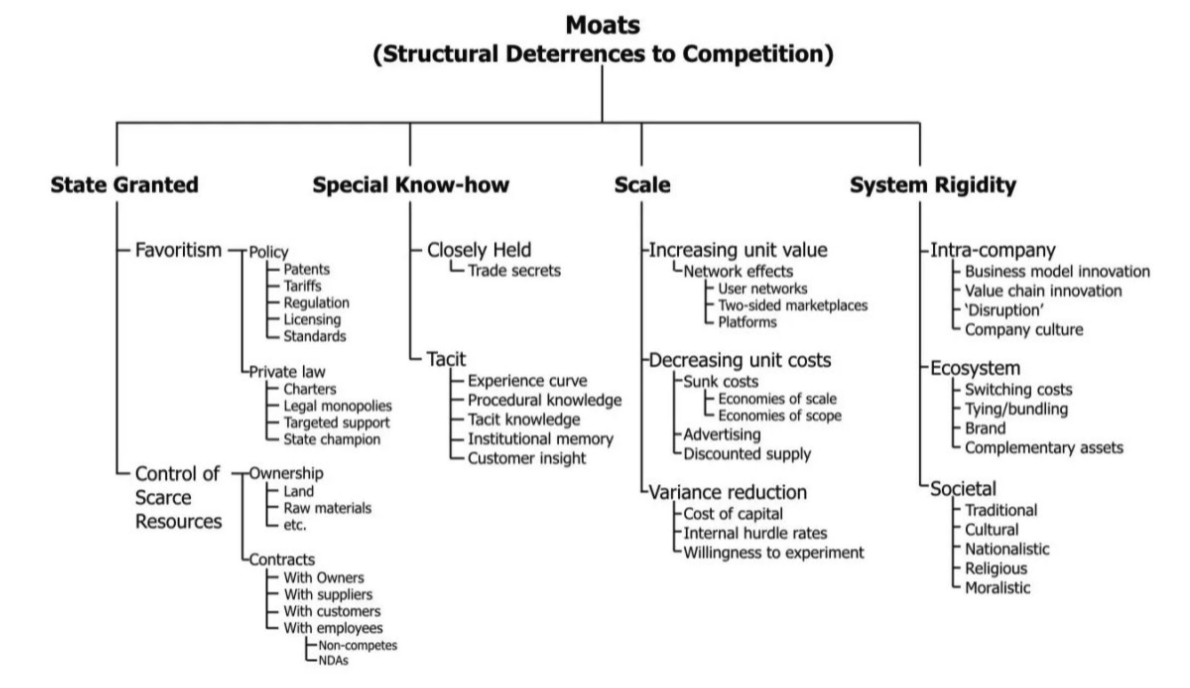
 Copied
CopiedComplexity is the amount of things you’ve to keep in mind before/when doing something. There are two types of complexity: accidental complexity and essential complexity. It is the job of the product organization to drop complexity.
Why it matters: As a system grows, it becomes complex. You should care about it because Complexity slows down execution. Hence, ruthlessly identify and shed as much accidental complexity as possible.
How to handle it
- Always do pre-mortem to breakdown information you’ve into: Known Knowns (Facts), Known Unknowns (Uncertainties or Questions), Unknown Knowns (Blindspot or Intuition), Unknown Unknowns.
- Be on the lookout for Wicked Loops
 Copied
CopiedUsers are able to use products for free because they give their time and attention which is then monetized through advertisements.
The customer’s perspective
Companies invest in advertising for:
- Brand Development: Brands advertise to maximum folks should know about your product (Owned Identity) to drop their Customer Acquisition Cost. All print and TV advertisements were for brand development. In such campaigns, the focus is on CPM while maintaining a basic CTR.
- Performance marketing: In this brands get Paid or Acquired Traffic for a specific business objective, for example, app installs, lead generation, or conversions. Agnostic to the method you use, what matters is the outcome that you promised and hence such advertisements are paid in the form of CPC, CPL, CPA, and CPT.
Companies will pay a premium for:
- Reach
- Performance
- If you can prove that the audience that comes to your platform is their target audience. Alternatively, if you can use artificial intelligence to target advertisements.
- If you can prove that your platform is a premium space.
Limitations of the ad-funded model
Indirect programmatic advertisement is bad for business and users. Yet, most companies adopt it because it is a relatively easy plug and play revenue channel.
Bad for business
- Bottom feeding. Most companies have not been able to monetize advertisements as efficiently as Google, Facebook, Amazon, and Apple. Hence, even when large organizations do direct sales of advertisements, they are fighting for the peanuts left behind.
- Downturns can hit hard. Companies spend on advertisement from their marketing budget which tends to be a variable expense. Hence, during a downturn or recession, ad-funded businesses are hit hard as companies stop spending this variable expense.
- Lack of consistency. Revenue from advertisements is seasonal.
- Converts your business into a commodity.
Bad for users
- Ideally, you must under-optimize. Adopting ads as a revenue model is all about managing tradeoffs: How to serve the needs of advertisers while retaining user delight.
- Eventually most will compromises on the product. Ad-funded economy has fused with acquisition through SEO. Hence, organizations tend to prioritize quantity over quality, i.e., create many low-quality articles to game the algorithm. Additionally, each story is valued by the page views it gets. Given that, a well-researched article and a funny cat video are measured by the same metric. Finally, the UX is extremely cluttered. It is this bad UX that has led to the creation of ad blockers.
Historical context
Ad networks solve a tangible problem:
- Without ad networks, it isn’t feasible for companies to individually buy advertisements from each website.
- Without ad networks, standardization of ad sizes and prices isn’t feasible.
Print and TV advertisements v/s Digital advertisements
What’s next
The pivot to privacy brings in new opportunities!
- The Internet is sunsetting the third-party cookie. Various governments are enforcing stricter privacy rules. Finally, platforms like Apple are by default disabling tracking.
- Companies that have implemented their own DMP that tracks First Party Data will be able to target advertisements better. For example, Vox’s Chorus.
 Copied
Copied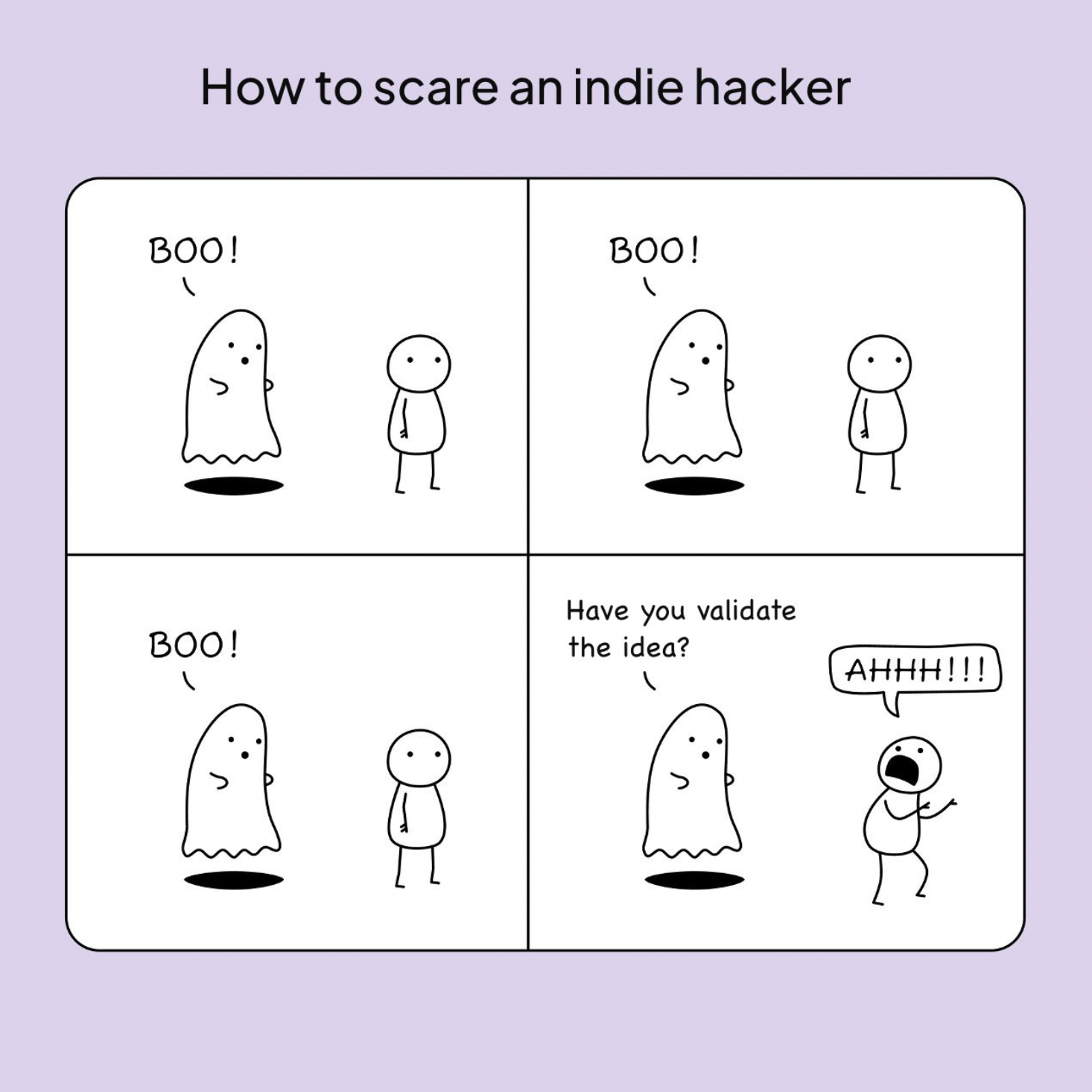
How does that make you feel?
- But what about tomorrow? What about the improvements you are considering making that none of your customers have seen yet? No segmentation can help you evaluate these options since you have no data.
- The only way to understand how the future will affect your customers’ happiness is to speak with them. That might not sound very data driven, but you need to treat customer discussions like data collection exercises! If you don’t, you may unwittingly introduce bias into the feedback you collect which will drive you to false conclusions.
- When getting ready to talk to customers about new features and updates, make sure to always do the following:
- Randomly Select Customers. Don’t just talk to the customers you already know well, or the ones that are the easiest to reach. Always randomize the customers you collect feedback from to ensure they are a good sample. Remember that not all customers will have time to talk to you so choose a large enough group that even though not all will participate you’ll still have enough interviews.
- Always ask the same Questions. It can be tempting to simply sit down with customers to have a discussion about prototypes and designs. However, such unstructured discussions give you uneven feedback and make it difficult to avoid bias. Be sure to have the same set of questions for all customers.
- Focus on Feedback, not Imagination. Customers often have a hard time imagining ideal solutions to their problems, but they are great at providing feedback about potential solutions you put in front of them. Instead of asking them how they would like you to solve something, show them some options and allow them to choose.
Those of you familiar with survey design will find these familiar! That’s because the same rules of good survey design apply to customer interviews as well. There is a great detailed breakdown of survey design available from the Pew Research Center.
Even after doing these things it might seem difficult to turn qualitative feedback into data driven decisions, so tomorrow we’ll cover more sophisticated models of processing feedback (known as Customer Satisfaction models). They will help you turn your customer interviews into a highly data driven exercise!
Questionnaire design – Pew Research Center Methods | Pew Research Center (archive.org)
 Copied
Copied“Does it work? Let’s try it, and if it does work, fine, let’s continue it. If it doesn’t work, toss it out, try another one.”
Lee Kwan Yew
Experiment-driven development entails running tiny tests to evaluate options/ideas that you’ve in an iterative and structured fashion to incrementally achieve results.
Why it matters
Strategically
- Always scale after achieving fitment. Optimizing too early stunts iterative discovery.
- Incrementally discover and improve towards a larger goal.
Operationally
- Speeds up discovery. Short iterative experiments will pop-up the unknowns. Additionally, the process forces you to stop and reflect.
- Encourages risk-taking: An experiment might fail to achieve what we set out to do, but it succeeded in teaching us something new about audience. Additionally, each experiment is tiny enough that it does not result in outright failure of the product.
- Helps convince. Gives you ammunition to convince others with evidence.
- Helps seek permission. It comes from the vantage point that you don’t know and hence you will experiment. This helps bypass egos and strongly held positions. Additionally, each step is tiny so its easy to convince stakeholders to try it out.
- Promotes customer-centricity: Each experiment’s output is based on behavioral analytics.
How
- Build a culture of asking questions and proposing explanations as hypothesis based on the limited information available.
Phrase all ideas as hypothesis. “What if we…”
- Estimate data for each of the hypothesis using the RICE model.
- Reach: How many users will use it?
- Impact: What outcomes (business metrics) will it grow and by how much?
- Confidence: Given your capability and constraints, how difficult would it be to test this
- Effort: What would it take to implement this
- Prioritize which hypothesis to focus on
- Design your tests
- Define context: What do you know? What do you have access to? What do you think is going on? What do you want to find out?
- Summarize prior research: How have you experimented in this area before? What did you learn from your results and analysis? What further research do you need to do before you start the experiment?
- Obstacles and risks: What are the risks in the following areas: Business, Usability, Technical? How will this affect? How will you mitigate these results?
- Success: What is the primary success metric? What is the secondary metrics that this experiment will impact? What is the benchmark today? How much do you expect it to change?
- Who and how many: Who will you test this on? Use Sensitivity Analysis to identify how large should be the sample size.
- When: When will you conduct this test? How long will it last?
- Conduct the tests
- Do anyone need it? Qualitative Research, Interviews, Paper Sketch.
- They need it. Would anyone use it? Build an unscalable version, for example, prototype in Figma.
- Does a significantly large audience need it? Digital advertisement campaign with a landing page
- How do we build the product properly? A/B Testing, Multi-armed Bandit
 Copied
CopiedShort Shelf-Life content is content that experiences an immediate surge in interest, which then quickly declines. Most news content falls in this category because it often reports on events—breaking news, summits, natural disasters, ‘He said She said’, deaths, etc.
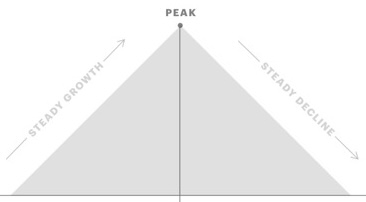
Below is Google Trend on the keyword Bipin Rawat.
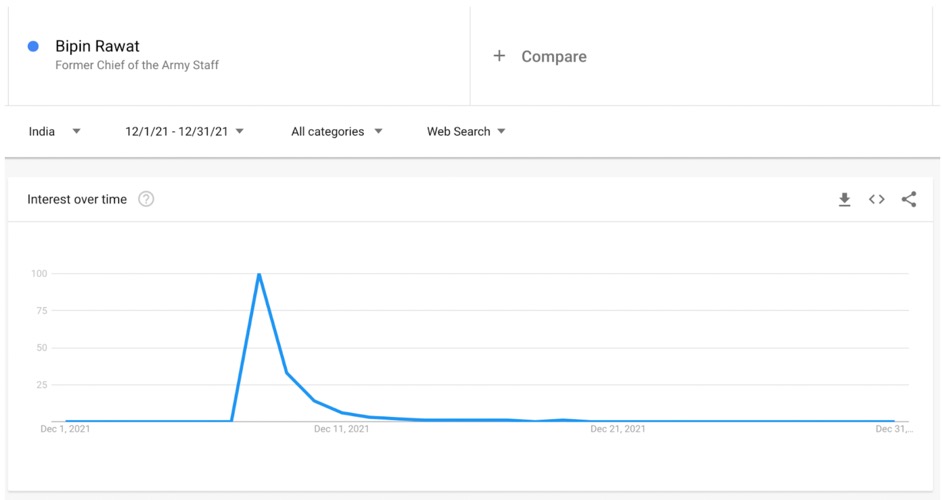
 Copied
CopiedLong tail stories maintain consistent levels of traffic over extended periods because of their enduring relevance.
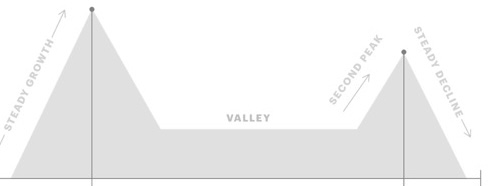
 Copied
CopiedFor every query, Google Trends returns data that is normalized in relation to a peak (100). Here’s the response when you search for the topic Yogi Adityanath.
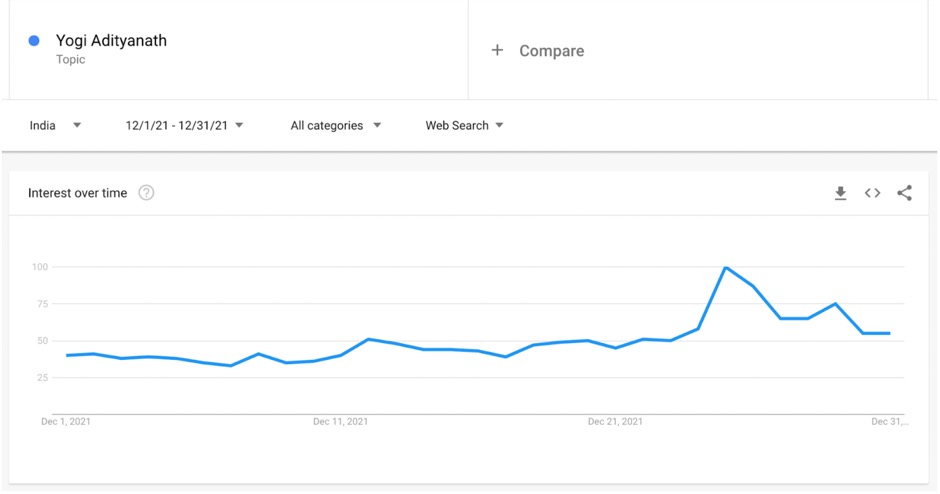
Lets run a similar query for General Bipin Rawat

This makes it impossible to compare these two terms. Hence, we introduce a neutral term – say “Google News”. And now we get these results.
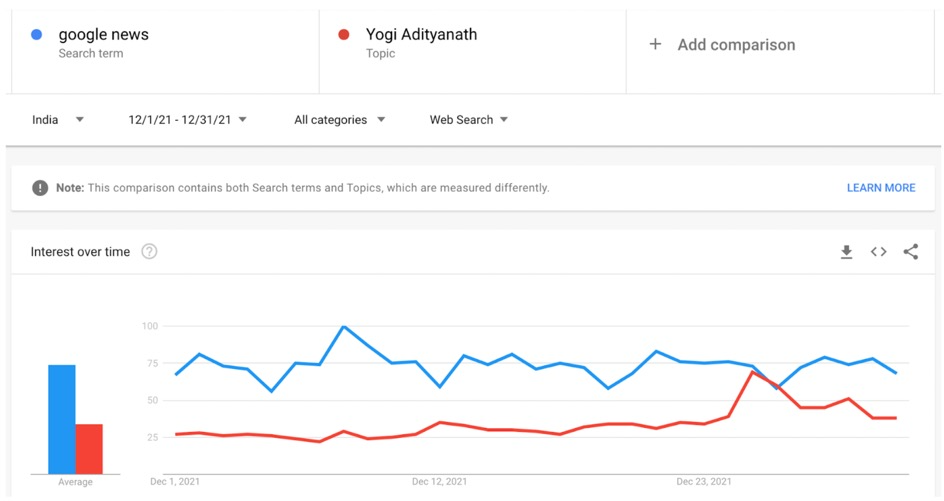
How to normalize? We need to make the traffic data from Google Trends comparable between Google News, Yogi Adityanath, and General Bipin Rawat.
Response from the query for General Bipin Rawat on December 8, 2021.
- Google News: 1
- General Bipin Rawat: 100
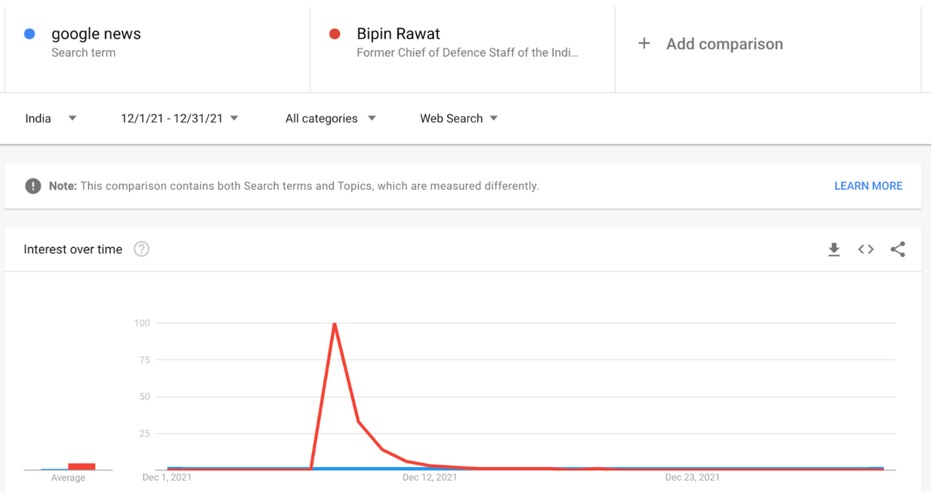
Response from the query for Yogi Adityanath on December 8, 2021.
- Google News: 100
- Yogi Adityanath: 28
Normalized result using min-max scalar.
- Google News: 1
- General Bipin Rawat: 100
- Yogi Adityanath: 0.28
 Copied
CopiedThe business case for launching Apps
- Apps are great for Digital Advertisements based media products because even if your app user base is a fraction of your browser user base, the app user base will give you drastically higher Sessions Per User. This is generally because it is easier to build Habit-forming on apps due to Push Notifications.
- Additionally, the eCPM rates on the app is much higher than browser eCPM.
- App users tend to convert better to buy Subscription.
Do competitor research with AppAnnie
Paid or Acquired Traffic: As of 2020 in India, it typically costs Rs. 50 to acquire mobile app downloads. For these users, you’ve to be confident that the product is strong enough to grow Sessions Per User so they stick around and give you enough revenue in the long run. Another way to track this is to look out for Uninstall to Install ratio.
It seems most media businesses, at least in India, have not built Profitable mobile apps.
 Copied
CopiedHabit-forming products have a clear trigger-action-reward.
- In editorial products, push notifications, newsletters, and podcasts tend to be habit forming.
Why it matters:
- Habit-forming products increase sessions per user or DAU/MAU, i.e., they get users back to your platform regularly.
- This in turn drops churn.
- Consistency leads to trust.
Will customers miss you if you are gone tomorrow?
Examples
How Supreme cultivated a purchase habit
You’ll not find Supreme’s goods on Amazon or in another store.
Trigger: Like clockwork, every Thursday at 11:00 am during the spring and fall season, Supreme drops a limited collection of merchandise on its website. This fixed time and location reinforce the habit. Customers know when to expect new merchandise.
Action: Hence, they keep coming back to the Supreme website every week. It also creates excitement, rumors, and conversations within the community.
Reward: Find out what’s new.

The Times of India’s Start Your Day With brought the newspaper’s funny pages online
Print newspapers have always had the back-of-the-page infotainment section page. This page typically includes comic strips, brainteasers, crosswords, horoscope, events listing. Traditionally, it has been one of the pages which has had high engagement and time-spent with newspaper readers.
Trigger: Before cell phones went mainstream, it was common to see people interacting with this page during their time off. While Page One was the morning trigger, the funny pages with cartoons, games and comic strips was the reason you picked up the paper later in the day or carried it around with you. It was also one of the early use-cases for young readers — many began their newspaper reading with the comic pages.
Action: Read or play for entertainment.
Reward: On reading this page, the reader got clear well-established rewards:
- The editorial cartoon informed and entertained
- The crossword and brain teasers gave a sense of challenge and achievement
- The listings and horoscope had straightforward utility
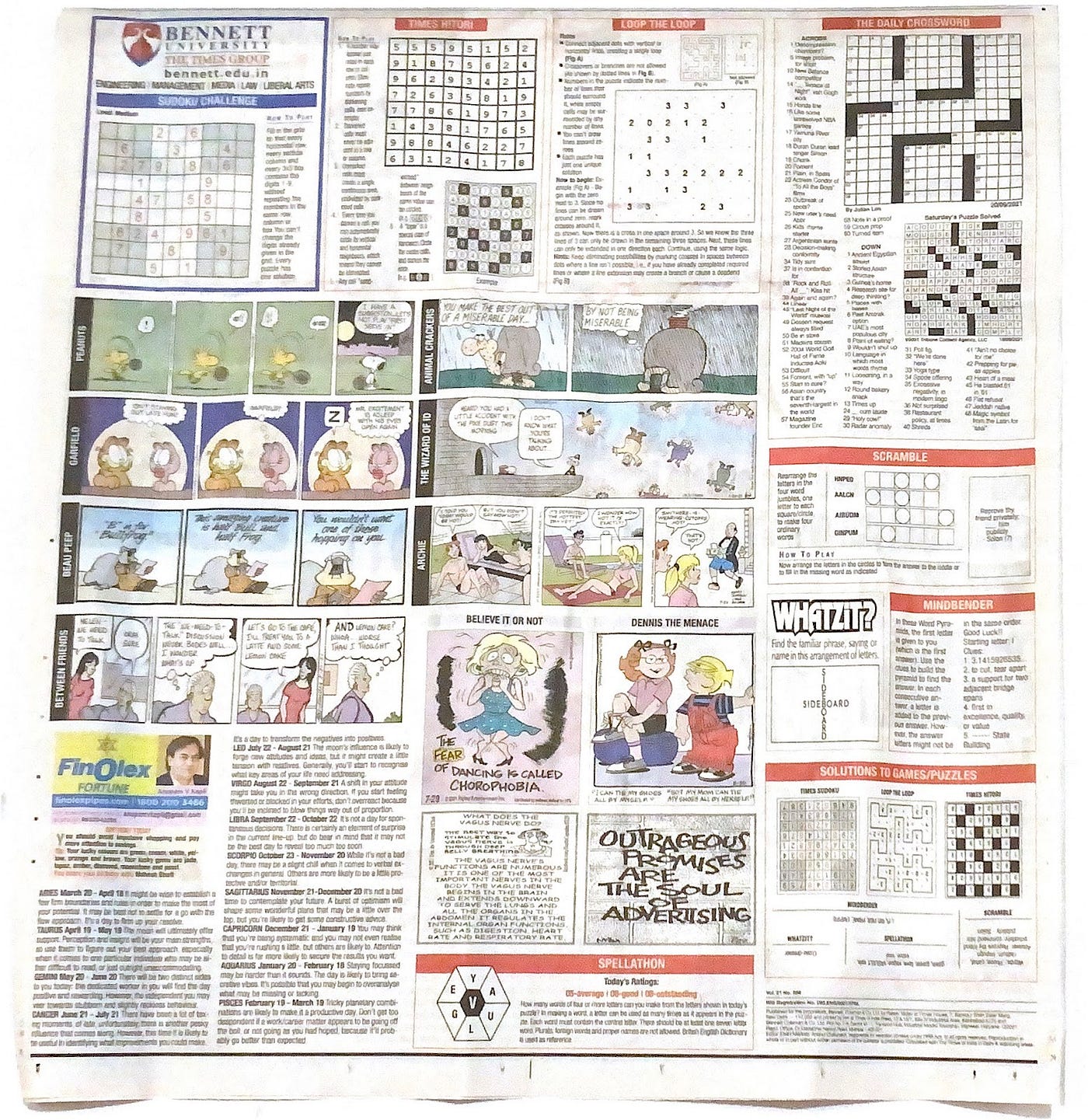
Axios
Everything about Axios was habit-forming:
- How: Axios’ Smart Brevity provided a consistent style of copy that sped up reading
- What and When: Newsletter that reach you at a pre-defined time
- Who: They gave away equity to their employees whom they nurtured into celebrities. For example, Sara Fischer’s reporting on media.
 Copied
CopiedWhat do journalistic investigation, dating, sales, and hiring have in common? Each of them are funnels towards insight, partner, customer, and employee respectively. This same concept can be expanded to value generating outcomes like Conversion, Retention, Ad Click, etc.
A funnel is a series of events or actions that customers need to take leading up to a value generating outcome. You start broadly (Top of the Funnel) and then increasingly narrow down into what you want.
Why it matters: A funnel models reality and exposes steps in the funnel that need to be optimized.
How do you know it is good?
- Funnel conversion rate benchmarks vary based on geographies, product categories, and industries. Always be on the lookout for openly available benchmarks like here and here.
- For ease of analysis, use Segmentation to simplify multi-path funnels into single-path lines.


Optimizing funnels:
Actively use A/B Testing or Multi-armed Bandit to optimize your funnels:
- Increase Top of the Funnel but that costs money
- Change the user experience to drop drop-offs
- Use Propensity Modeling to provide Discounts and Promotions, etc. at the right spots
- Drop steps in the funnel much like Amazon’s one-click purchase
Build and maintain an Audience Funnel
 Copied
CopiedOnboarding helps orchestrate evolving users from one segment to another.
Why it matters: Like all people, customers change over time and go through a Customer Lifecycle. The more a customer learns about your product or service the better they will make use of it and the more advanced their usage will become. Onboarding helps them evolve.
- In Subscription products, it helps users get the most out of their purchase. This in turn, increases retention rates and LTV. The converse is also true. People will churn if you’ve not established a relationship with them. Onboarding can help you activate sleepers — subscribers who pay but don’t use the product.
- For users who have recently installed your Mobile Apps, onboarding can help improve D1 retention.
- Additionally, as users perform actions, you’ll end up collecting First Party Data which in turn ends up cold-starting Personalization.
- Fitness products track and reward usage streaks to increase DAU/MAU and sessions per user.
How
Setup: On sign up or purchase, thank them immediately and offer help to engage further with your product.
- Sometimes this can be a ‘Complete your setup’ wizard with few mandatory steps. Other items, it is a sticky widget that stays until the user completes those steps.
- Typically, you’ll get them to engage with all your Channels: Websites, install Mobile Apps, sign up to Newsletters, subscribe to Push Notifications and even validate email or open a Push Notifications.
- You can also get them sample your features and content across the Information Architecture.
- Celebrate if the user completes all of these steps.

Auto-responder campaign: You also want to run a Newsletters campaign that introduces the user to your mission, introduces your staff, serve them your most popular content, and ask them questions about their motives and interests. This could be as simple as asking them about their favorite local restaurant. The goal is to kickstart a two-way communication.
On-platform nudge users to towards specific actions. For example, ask them to leave their first comment, poll their opinion about topics, after a story ask them what else they they would like us to cover or share tips on what they could have done better. Some platforms like Stack Overflow offer points to encourage usage.
Risk: Beyond this point, you cannot keep bombard or overload the user with everything in one go. Instead, your must progressively narrow down to specific personalized actions, features and topics.
- +1: Encourage your users to share the product with someone else in their Owned Network.
- Invite them to an exclusive event or for a Ask Me Anything with your staff
- Build Transformative work products for them so they can do deeper into certain topics
- Ask them to follow staff on Social
- Constantly communicate to them about the new product features that you are launching for them
How long: You could start off with a fixed period onboarding but ideally you should go on until user graduates to desired engagement level on the Customer Lifecycle.
 Copied
CopiedRunning push notifications
- Etiquette
- Have a per user day cap, i.e., have a upper limit to the number of push notifications that can be sent to a user per day.
- Measuring performance
- Setup a funnel to track: Push notifications sent, Delivered, Opened, and Clicked.
- Be on the look out for audiences unsubscribing to push notifications or uninstalling your app after receiving push notifications.
What to optimize
- Consistency
- Optimize CTR
- Explainability in stories
- Reading Windows
 Copied
CopiedThese are audiences whose identity you know. It could be as simple as an email address or phone number. To acquire them, get them to login to your website, download mobile app, or subscribe to your newsletters. For such audiences, you can use personalization to drive up pages per session through smart homepage, newsletters, push notifications, and onboarding.
Why it matters: You should collect their data in a customer data portal and use it improve your engagement, drive subscriptions, relationship with audience, etc.
 Copied
CopiedAs per newslifespan.com, there are four types of news topics:
- Short Shelf Life content, like Breaking News
- Long Tail
- Slow Build-Up: Events such as the World Cup and elections exhibit a gradual increase in attention, climaxing at the event’s culmination.
- Decaying Big News: Initially, a major news event captures widespread attention, but public interest gradually wanes over time.
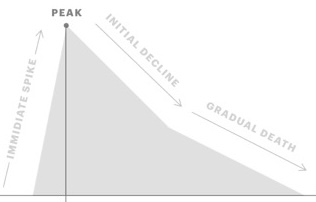

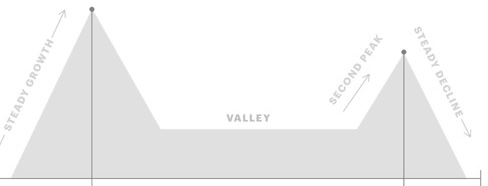
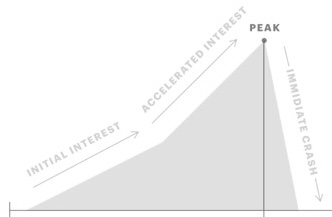
 Copied
CopiedYou’ll need to adapt as you implement the subscription revenue model. Subscribers give you time, attention and money. Hence, all your decisions need to answer what’s best for your subscribers!
- On revenue diversity: You’ll need to work on your user experience so subscribers feel well served. Hence, indirect digital advertisements and subscription don’t gel well. To implement digital advertisement in subscription products, you’ve to serve premium advertisements that your audiences will appreciate.
- On owned identity: Once you move to subscription, you cannot claim to remain “the paper of record”. Your editorial judgement will start reflecting the values of your subscribers.
- Who drives and amplifies: Once a simple subscription stack is in place, then the editorial team can directly serve value to the customer! Given that the drivers are the editorial teams and product and engineering can amplify their impact.
 Copied
CopiedWhy it matters: eCPM for logged-in or on apps is much higher than anonymous users on the browser.
- However, most digital publishers lack First Party Data because they have not invested in getting audiences to login or install their app. Hence, they cannot prove who is coming their platform.
How: You can collect information by converting Anonymous Audience to Identified Audience, running Progressive Disclosure campaigns or simply by asking a post purchase questionnaire. Examples:
- Google knew this and hence gave away Gmail, etc. so people login. Amazon knows this and hence Amazon Prime Video, Audio, etc.
- Media publishers lack Identified Audience and hence systems like Lotame reverse engineer who is the audience statistically from the kind of content they consume
 Copied
CopiedLike Personalization, even item ranking algorithms are Editorial Products because they demonstrate Editorial Judgment.
Why it matters: One might not have the resources to implement Personalization or might want to start with something simpler. In this situation, use data science or basic machine learning to implement user-agnostic item ranking.
How: You can train different item-ranking models for different use cases (recirculation, conversion), retention and cohorts (logged out, logged in, subscribers). For this, you might want to use datapoints like:
– Pageviews
– Reading Time = Avg. Time On Page x Page-views
– Topic rank
– Time decay
– Subscriptions|Subscription Conversion|conversions and renewals
– Age of the article
Future potential: Currently, most item ranking models run at a Posts level. A better approach would be to have models that run at phrase or sentence level, allowing for inline linking.
 Copied
CopiedProgressive Disclosure campaigns help build up First Party Data which in turn helps you build Personas, Segmentation, and Target advertisements.
 Copied
CopiedUse text similarity solutions like Lucene or Topic Modeling algorithms like Top2Vec or BERT to find related stories.
 Copied
CopiedWe write one article for everyone. However, in real life, would you tell a story to a close friend, an office colleague, and a child in the same way? Today, personalization is labeled “For You.” In the future, it will be “Written For You.”
Here’s how:
- Just as Google Sheets stores formatting separately from information, editorial teams will have to Separate information from formats.
- Let LLMs (Large Language Models) rewrite them for each user.

 Copied
CopiedWhen you are giving constructive feedback, ensure you are clear whether you are implying that this isn’t for you — you lack skills or leverage for this or
- This isn’t for you — you lack the skills or leverages for this
When you are giving feedback know whether you are implying the person lacks ability, or if you believe they have higher potential that this work does not reflect.
When you are giving feedback ensure that how you deliver
This doodle best showcases 😅 what frank conversations with mentors, who have at least a decade more experience than you, feel like: tactically, you realize gaps in your thought process 🤕 ; strategically, it offers great course correction 💪🏻.

 Copied
CopiedLeverage a “participatory design” approach as they seek to solve the stakeholders’ problems, engaging with them directly instead of making wild guesses. People are at the heart of technological developments like these. Hence, the goal was not to put technology first, but be stakeholder first as a platform. The stakeholders are periodically invited to the office to have long conversations to discuss the app’s features and challenges.
– Dharmesh Ba in https://newsletter.theindianotes.com/p/story-of-namma-yatri-part-1
 Copied
CopiedI absolutely loved Sharad Sharma’s articulation. He says, and I paraphrase, in a 5-day test match, it’s acceptable to have periods of rest. Then came the one-day international matches, condensing play into 4-5 hours of intensity (one innings). This shift drastically increased the demand for fitness. Being a Gavaskar was no longer sufficient; you needed to be a fit Gavaskar. The demands for fitness, temperament, and skill escalated further with T20 matches.
Similarly, our careers are undergoing a transformation. Will most of us be able to transition from test matches to ODIs to T20s, adapting to these changing times?”
 Copied
CopiedRecently, I met with a decade-long acquaintance, someone whose insights I’ve admired, to seek advice. In our conversation, I confided in him, expressing my frustration at not being able to pinpoint my core strength, given my experience across diverse fields, and my lack of a clear specialization.
With the composure of a Zen master, he offered a one-word revelation, “Sense-making!”
His voice carried a note of certainty as he continued, “That’s your superpower, and it’s a skill highly valued by all CXOs. More often than not, the challenge in leadership isn’t just getting things done, but in making sense of ambiguous problems, deciphering them so that solutions become clear.”
😶 Huh! That is such a clean and simple articulation.
 Copied
CopiedLikely Factors
Twitter understands what is important based on if the content is about a big handle and if the topic in the content is being spoken about by big handles.
Observations
It seems that Twitter has implemented a rule on top of its recommendation algorithm. It’s common to see a retweet or reply to a specific tweet, let’s call it ‘Tweet X,’ in your feed, followed shortly by the original ‘Tweet X.’
- This pattern suggests that ‘Tweet X’ is surfaced through the personalization algorithm, while the retweet or reply is introduced by a set of rules.
- These rules likely operate under the assumption that if you are interested in ‘Tweet X,’ you would also be interested in related content.”
 Copied
CopiedI recently saw a subscription-based product use this phrasing for their Customer Dependency Index survey: ‘How would you feel if the product was not available from tomorrow?’
The Product Manager must have thought: ‘Let me gather these responses to demonstrate to stakeholder how dependent our users are on our product.’
Meanwhile, the customer thinks: ‘Hey there! I’ve already paid for an entire year. What are you implying? Shouldn’t I be able to rely on your service?’
 Copied
CopiedMost Annual Operating Plans happens in the horizons of one or two years. However, this doesn’t take into account the larger shifts happening in our environment and how vulnerable you are to it. Thus, by the time you get to it, the larger environment has already changed and you are still playing catch up. This is not only applicable to business/work but also to one’s career, one’s health and personal finance or even parenting.
Martin Wolf of the FT has a neat framework to help think through how the larger environment is changing. He argues that one should list the shifts, shocks, and fragility in your system and include them as factors in your planning.
- Shifts: Long-term structural changes that are occurring and are likely to continue. These changes are something you cannot control and have to adapt to.
- Shocks: Absolutely conceivable Black Swan events that could happen but we cannot forecast when and then they do happen — Covid-19, Israel-Palestine War, Russia-Ukraine War, etc.
- Underlying Fragility: Characteristics of the system that make these shocks so destructive.
 Copied
CopiedThere are three types of audiences:
- The first type is your owned network. These are individuals you know personally, who will respond to your messages and answer your phone calls. Adding people on LinkedIn or Facebook does not mean they are part of your network.
- The second type is audiences to your owned media. This group includes people whose email addresses you have, those who subscribe to your WhatsApp channel, or follow you on social media. Essentially, when you reach out to them, there’s a chance they will read your message. Your audience invests their time in you, which equates to their attention.
- Finally, the most valuable type of audience is a community. A community represents the highest form of audience engagement because people actively choose to meet and interact with others through your owned media. This community not only invests time but also contributes effort. They gather on your platform, giving you the opportunity to bring together the right individuals in a meaningful way. You can encourage them to share insights, experiences, challenges, and predictions they might not disclose in public settings.
- Recently, I was at a closed-door, invite-only meeting of CTOs at Microsoft where they had employed Chatham House Rules which means you use what is discussed but not quote who said it. Microsoft has the power to convene and drive open conversations.
A common mistake is to leap from an owned network to a community without first cultivating an audience. In most successful scenarios, there is a natural progression: network leads to audience, which then evolves into a community.
 Copied
CopiedThe best online content is written by nerds (natives) in a topic for nerds (natives) in the same topic. Most of us are silent bystanders — Immigrants, Tourists, Enthusiasts — who observe these two groups conversing on the nuances of the topic of interest.
Most marketing is about increasing the surface area by expanding your reach outward. In contrast, most sales are about bringing outsiders in.
For example, Apple used to be a company that sold $2000 laptops. Then Steve Jobs launched iTunes for Windows, a free music management software that everyone could download. This was followed by the iPod, a $100 device. Slowly but steadily, everyone could try, taste, and understand the value proposition of Apple and move inward from enthusiast to tourist to immigrant, until they eventually became natives.
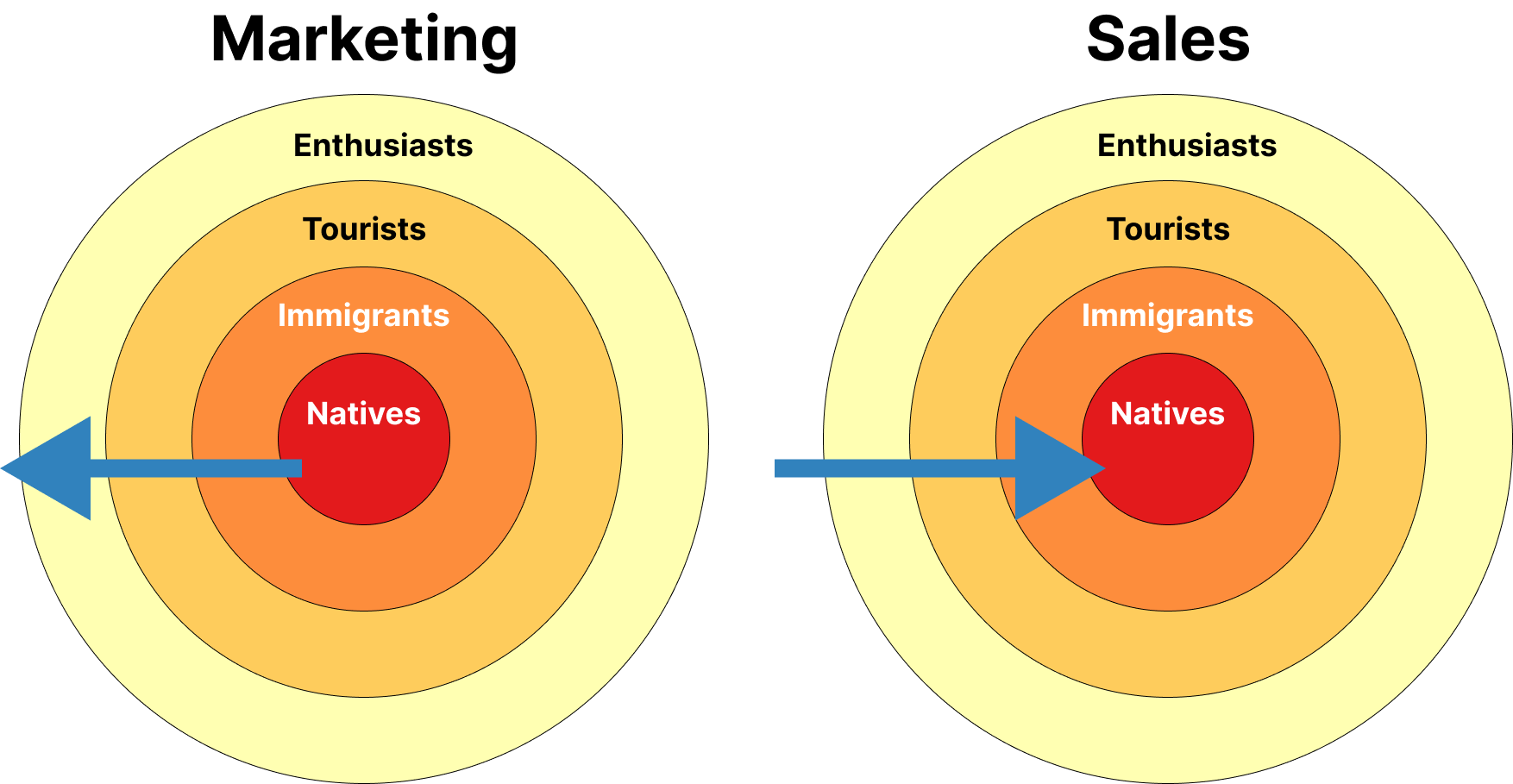
 Copied
CopiedWatch a child learn, and you’ll notice that most aspects of their development are information problems.
- Information: What is an 🍎? We need to teach children to call it an ‘apple’.
- Ability: How to draw with a ✏️? We need to teach children to hold a pencil and draw straight lines.
- Action: Should one eat 🥦 or 🍕? We need to persuade kids to build an appreciation for the former.
- Belief: Should one steal? We need to help children build a perspective about what’s good or bad.
 Copied
CopiedStrategizing content based on audience preferences isn’t sustainable because you’ll end up building an inauthentic identity. Instead, the content you create should reflect the life you live. It should articulate your experiences and insights.
Go pick a field where you have deep leverage — skill, judgment, network, location, culture, etc., or you have deep interest and thus are willing to jump into it fully.
Just do great things and talk about it. But for that, you first need to start building rigor for documentation and writing.
 Copied
CopiedBrian Chesky: To turn around a bad situation, write down all your current activities in a Google Sheet. From this comprehensive list, strategically select only 20% of these tasks to continue, ensuring that our efforts are concentrated on the most impactful areas. Remove multiple layers of management and transition from a divisional organization structure to a functional one. Finally, rely on a smaller but more senior workforce.
Costco. Costco keeps an extremely low SKU count. A Walmart will have 100,000-250,000 SKUs at any given moment of time. Costco in the last 10 years used to be at around 4500 and now they have further reduced it to 3800.
 Copied
CopiedBrian Chesky’s comments in his interview with Lenny paraphrased: In most situations, engineering and marketing operate in different universes. Marketing focus on either performance marketing (tactic) or brand marketing (too strategic). When both work closely, you get product marketing, which is an educational tool, informing both internal teams and customers about the unique benefits of what’s being created.
- This involves various strategies such as demonstrations, storytelling through video content, and considering every customer touchpoint to ensure comprehensive understanding.
- The essence of Chesky’s approach is twofold: first, create an outstanding product, and second, ensure that people know about it.
- This involves framing each product release as a chapter in an ongoing story, making it relatable and memorable.
- Such a narrative approach not only captivates the audience but also bridges the gap between the technical brilliance of engineering and the persuasive art of marketing.
Amazon: Similarly, Amazon advocates that product managers start their projects by first writing a press release. This forces them to craft a compelling narrative.
 Copied
CopiedProduct Managers do not shape the product; instead, they focus on serving management by shipping features as quickly as possible. Over time, the codebase becomes unshapely and messy. This, in turn, makes the codebase fragile and slows down execution.

Brian Chesky’s comments in his interview with Lenny paraphrased: Most product managers are caught up in the mechanics of execution — getting requirements from management, ensuring timely execution by design and engineering, and shipping the output. However, this is akin to running a “services engineering organization” rather than leading a product. In contrast, product management is about leading the vision of the product, shaping its design, and nurturing the creativity and innovation that go into building it — all in service of user needs.
 Copied
Copied
Users spend 10x to 20x more time on social media compared to the time they spend on news media. Given that, it is recommended to invest in both native (on-platform) and social footprint and sell both as part of direct ads.
- Direct sales. Micro-celebrities can charge brands anywhere from Rs. 30,000 to a lakh for a social media post. Top cricketers charge a couple of crores for a post on their social media handles. This is especially true for videos.
- Subscriptions. Referral traffic from Twitter tends to give much higher subscription conversions compared to traffic from other sources like Facebook.
TV news anchors have a vast following. Do news companies monetize on their social following and do influencer deals?
“a growing trend of advertisers beefing up their influencer marketing budgets, including companies that you wouldn’t typically associate with creators. Next year, spending on influencer marketing in the U.S. is expected to rise nearly 15% to $5.89 billion, according to a forecast from Insider Intelligence.”
“Influencer marketing has been a way to reach customers who don’t know about the company. “The creator economy is huge for that because they’re hitting up people in various stages of the buying cycle,” said Ravichandran. “The person is not ready to buy, but then something will happen … like somebody tried to steal [their] credit card.” When that happens, the individual may remember the creator’s message and subscribe to Aura.”
– Why a Cybersecurity Startup Is Boosting Its Influencer Marketing Budget
 Copied
Copied
